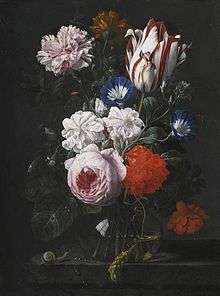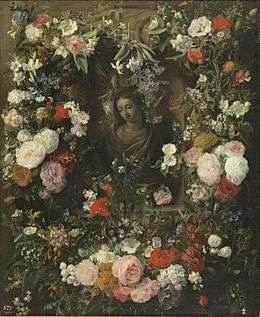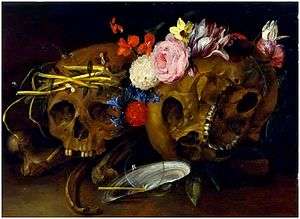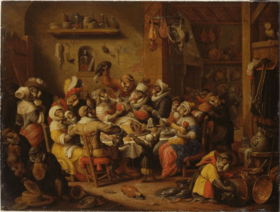Nicolaes van Verendael

Nicolaes van Verendael or Nicolaes van Veerendael[1] (Antwerp, 1640 – Antwerp, 1691) was a Flemish painter active in Antwerp who is mainly known for his flower paintings and vanitas still lifes. He was a frequent collaborator of other Antwerp artists to whose compositions he added the still life elements.[2] He also painted a number of singeries - scenes with monkeys dressed and acting as humans.[3]
Life
Nicolaes van Verendael was baptized in the St. Andrew's Church in Antwerp on 19 February 1640.[4] He trained with his father Willem van Veerendael.[5] He was not formally registered as a pupil at the Antwerp Guild of Saint Luke but was admitted to the Guild as the son of a member in 1657.[4]
He married Catharina van Beveren, the 17-year old daughter of the prominent Antwerp sculptor Mattheus van Beveren.[6] The couple would have 11 children, one of whom was born after the death of the artist. Despite his high reputation among fellow artists, van Verendael was never out of financial trouble as he was a slow worker. As a result he lived modestly.[2]
He was the teacher of someone referred to as 'priest Cano' and the flower painter Jean Baptiste Morel.[2]
Work

Van Verendael mainly painted flower pieces, vanitas still lifes and a few allegorical scenes with monkeys. His dated works are from the period between 1659 and 1690.[7] He was highly regarded from an early age when he started working with some of the leading Antwerp painters such as David Teniers the Younger, Gonzales Coques, Erasmus Quellinus II, Jan Boeckhorst, Carstian Luyckx and Jan Davidsz. de Heem.[2][4]
His early work shows the influence of the leading Antwerp flower still life painter Daniel Seghers but he used more and stronger and more contrasting colours. His early flower paintings depicted small, bright, graceful bouquets in tall, narrow vases or cartouches and garlands surrounding a religious figure or scene.[5] These garland paintings had been an invention by Jan Brueghel the Elder dating to the beginning of the 17th century and were usually collaborations between a still life and a figure painter.[8] An example of a work by van Verendael in this genre is the Garland surrounding the Virgin Mary (Prado, Madrid) a collaboration with an unknown collaborator. The central motif is a sculpture rather than a painting of the Madonna as was more common. The garland of flowers is represented in groups, rather than in a circle, and is thus representative of the later evolution of this genre. The subject of the exaltation of the figure of Mary was a response to Protestant beliefs and is reinforced by the inscription 'ego flos campi' ('I am the flower of the field') at the foot of the bust. Long attributed to Jan Brueghel the Elder, the work was part of the collection of the Spanish Queen Elisabeth Farnese.[9]

Later he was influenced by Jan Davidsz. de Heem, Some of his still lifes include vanitas motifs and insects. Van Veerendael developed towards a brisker brushstroke in his later years and he found a personal style that was a forerunner of Flemish flower painting in the 18th century.[5]
Nicolaes van Verendael contributed to the spread of the genre of the 'monkey scene', also called 'singerie' (a word, which in French means a 'comical grimace, behaviour or trick').[10] Comical scenes with monkeys appearing in human attire and a human environment are a pictorial genre that was initiated in Flemish painting in the 16th century and was subsequently further developed in the 17th century. The Flemish engraver Pieter van der Borcht introduced the singerie as an independent theme around 1575 in a series of prints, which are strongly embedded in the artistic tradition of Pieter Bruegel the Elder. These prints were widely disseminated and the theme was then picked up by other Flemish artists in particular by those in Antwerp such as Frans Francken the Younger, Jan Brueghel the Elder and the Younger, Sebastiaen Vrancx and Jan van Kessel the Elder. David Teniers the Younger became the principal practitioner of the genre and developed it further with his younger brother Abraham Teniers. Later in the 17th century Nicolaes van Verendael started to paint these ‘monkey scenes’ as well.[3]
References

- ↑ Variant name spellings: Nicolaas van Veerendael, Nicolaas van Verendael
- 1 2 3 4 Nicolaes van Verendael at the Netherlands Institute for Art History (Dutch)
- 1 2 Bert Schepers, Monkey Madness in Seventeenth-Century Antwerp, in: The Rubenianum Quarterly, 2012 2, p. 5
- 1 2 3 Frans Jozef Peter Van den Branden, Geschiedenis der Antwerpsche schilderschool, Antwerpen, 1883, p. 1141-1143 (Dutch)
- 1 2 3 Els Vermandere. Veerendael, Nicolaes van. Grove Art Online. Oxford Art Online. Oxford University Press. Web. 29 September 2016
- ↑ Mattheus van Beveren at the Netherlands Institute for Art History (Dutch)
- ↑ Liedtke , Walter A. (1984). Flemish paintings in the Metropolitan Museum of Art. New York: The Metropolitan Museum of Art. ISBN 0870993569. (p.270-272, v.1; plate 105, v.2)
- ↑ Ursula Härting, Review of Susan Merriam, Seventeenth-Century Flemish Garland Paintings. Still Life, Vision and the Devotional Image
- ↑ Nicolaes van Verendael, Garland surrounding the Virgin Mary at the Prado
- ↑ 'Singerie' in Larousse online (French)
External links
 Media related to Nicolaes van Verendael at Wikimedia Commons
Media related to Nicolaes van Verendael at Wikimedia Commons